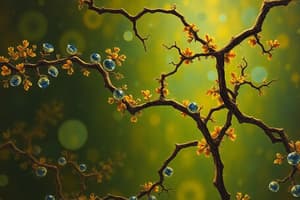Podcast
Questions and Answers
What is the function of ligands in the second messenger system?
What is the function of ligands in the second messenger system?
- They affect the same type of cells
- They act on another cell type in close proximity
- They are released at long distances
- They bind to receptors on target cells (correct)
What is an example of autocrine signaling?
What is an example of autocrine signaling?
- Ligands binding to receptors
- Insulin released by beta cells of the pancreas (correct)
- Molecules acting on another cell type in close proximity
- Histamine released by ECL cells
Which type of signaling involves the release of molecules that act on another cell type in close proximity?
Which type of signaling involves the release of molecules that act on another cell type in close proximity?
- Autocrine
- Neurocrine
- Paracrine (correct)
- Endocrine
What is an example of paracrine signaling?
What is an example of paracrine signaling?
Which form of signaling is the fastest?
Which form of signaling is the fastest?
What is a characteristic of juxtacrine signaling?
What is a characteristic of juxtacrine signaling?
Which type of signaling involves the release of neurotransmitters at synapses?
Which type of signaling involves the release of neurotransmitters at synapses?
What is a key feature of endocrine signaling?
What is a key feature of endocrine signaling?
Which form of signaling combines the functions of the nervous and endocrine systems?
Which form of signaling combines the functions of the nervous and endocrine systems?
What does neuroendocrine signaling involve?
What does neuroendocrine signaling involve?
Flashcards
Ligands' role in second messenger system
Ligands' role in second messenger system
Ligands are molecules that bind to receptors on target cells, initiating the second messenger system.
Autocrine signaling
Autocrine signaling
Autocrine signaling occurs when a cell releases a signal that acts on itself.
Paracrine signaling
Paracrine signaling
Paracrine signaling involves the release of signaling molecules that act on nearby cells of different types.
Example of Autocrine signaling
Example of Autocrine signaling
Signup and view all the flashcards
Example of Paracrine signaling
Example of Paracrine signaling
Signup and view all the flashcards
Juxtacrine signaling
Juxtacrine signaling
Signup and view all the flashcards
Neurocrine signaling
Neurocrine signaling
Signup and view all the flashcards
Endocrine signaling
Endocrine signaling
Signup and view all the flashcards
Neuroendocrine signaling
Neuroendocrine signaling
Signup and view all the flashcards
Neurosecretory cells
Neurosecretory cells
Signup and view all the flashcards
Study Notes
Ligands and Second Messenger System
- Ligands are signaling molecules that bind to receptors on target cells, initiating a cascade of cellular responses via second messengers.
- They play a crucial role in transmitting signals from extracellular to intracellular environments, influencing cellular metabolism, gene expression, and overall cellular behavior.
Autocrine Signaling
- Autocrine signaling occurs when cells release signaling molecules that bind to receptors on the same cell, leading to self-regulation and feedback mechanisms.
Paracrine Signaling
- Involves the release of signaling molecules that affect nearby cells, facilitating communication within a localized area.
- Example: Growth factors released by one cell type can stimulate nearby cells to grow and divide.
Fastest Form of Signaling
- Neuronal signaling is the fastest form of communication, allowing for rapid transmission of signals between neurons over long distances.
Characteristic of Juxtacrine Signaling
- Juxtacrine signaling requires direct contact between cells through gap junctions or adhesion molecules, allowing for immediate interaction and response.
Neurotransmitter Release
- Neurotransmitter release occurs at synapses, where chemical signals are sent from one neuron to another, enabling communication throughout the nervous system.
Endocrine Signaling Feature
- Endocrine signaling is characterized by the release of hormones into the bloodstream, allowing for widespread and prolonged effects on distant target cells.
Neuroendocrine Signaling
- Combines elements of both nervous and endocrine systems, where neurons release hormones into the bloodstream, influencing both neural and systemic responses.
Involvement of Neuroendocrine Signaling
- Neuroendocrine signaling involves the secretion of hormones from neurosecretory cells, bridging the gap between nervous system impulses and endocrine functions.
Studying That Suits You
Use AI to generate personalized quizzes and flashcards to suit your learning preferences.



